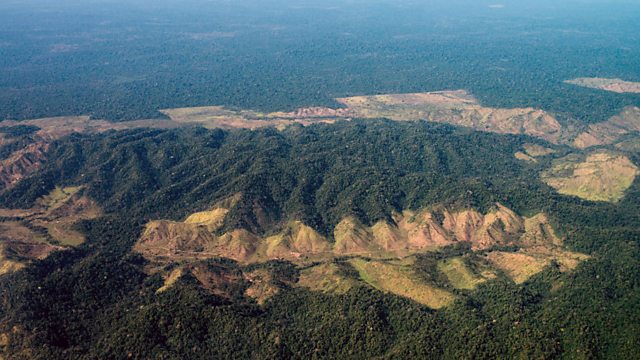Brazil Leads CO2 Emissions Reduction
Brazil CO2 emissions; Endangered World Cup football mascot; Rubbish fuel; Teenage talent
Brazil is the global leader in reducing carbon emissions according to a study published in the journal Science. The country has achieved this by reducing deforestation by 70%, which equates to keeping 3.2 billion tons of CO2 out of the atmosphere, but at the same time food production - of soy and beef - has increased, which is due to better yields on farmland. The study's lead author, Daniel Nepstad, heads the Earth Innovation Institute and is a lead author of the recent IPCC climate change report. He joins Jack Stewart on the programme.
Endangered World Cup Football Mascot
The mascot for the upcoming World Cup football tournament in Brazil is a fun-looking yellow creature, based on the three-banded armadillo, which rolls into an almost perfect, armoured ball when it is threatened. This iconic creature is listed as a vulnerable species as its habitat is threatened, and now conservationists like Professor Enrico Bernard from the Federal University of Pernambuco are challenging football’s governing body, FIFA, and the Brazilian government, to do more to protect it – particularly as the mascot will feature on millions of dollars’ worth of merchandise and souvenirs. Professor Claudio Sillero, a conservation biologist at the University of Oxford and a self-confessed armadillo enthusiast tells us more about some of the other armadillo species in South America and if they too face similar threats as the World Cup mascot.
Rubbish Fuel
Construction started recently of a new type of fuel plant in Essex, England, which will turn ordinary household waste into jet fuel. British Airways has pledged to buy the fuel and says enough will be produced to supply all its flights from London City airport, twice over, every year. The process uses "high temperature plasma gasification" technology to convert landfill waste into a gas, and which is then further processed into liquid fuel. Dr Colin Brown, Head of Engineering at the UK’s Institution of Mechanical Engineers, and Dr Neville Hargreaves, business development director at Velocys, the company behind the gas-to-liquid process used in the plant, explain how the process works.
Teenage Talent
Science in Action met up with Brittany Wenger from Florida. She is only 19 but has already experimented with neural networks, built prototype software to help doctors diagnose breast cancer, won a $50,000 college scholarship from Google and been invited to the White House to showcase her research. �鶹������ҳ��� Science reporter Helen Briggs met up with Brittany in London when she was over to speak at the Royal Society of Medicine.
(Photo: Aerial image of the deforestation next to Indio's reservation area in Para state, northern Brazil © AFP/Getty Images)
Last on
More episodes
Previous
Chapters
-
Brazil CO2 Emissions
The country is the global leader in reducing carbon emissions
Duration: 06:31
Brazil's Endangered World Cup Football Mascot
Can the three-banded armadillo be saved from extinction?
Duration: 07:08
Rubbish Fuel
A new type of fuel plant which will turn household waste into jet fuel is being built
Duration: 07:58
Teen Cancer Scientist
19 year old Brittany Wenger develops a cancer test
Duration: 03:48
Broadcasts
- Thu 5 Jun 2014 18:32GMT�鶹������ҳ��� World Service Online
- Fri 6 Jun 2014 01:32GMT�鶹������ҳ��� World Service Online
- Fri 6 Jun 2014 08:32GMT�鶹������ҳ��� World Service Online
- Mon 9 Jun 2014 03:32GMT�鶹������ҳ��� World Service Online
Podcast
-
![]()
Science In Action
The �鶹������ҳ��� brings you all the week's science news.


